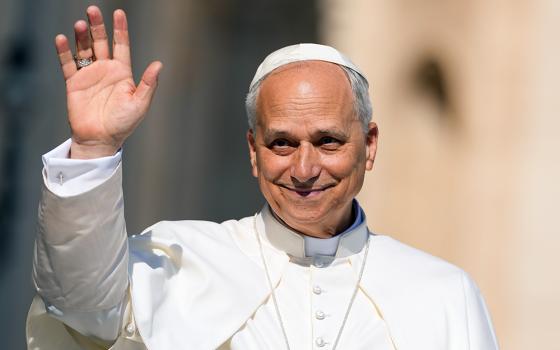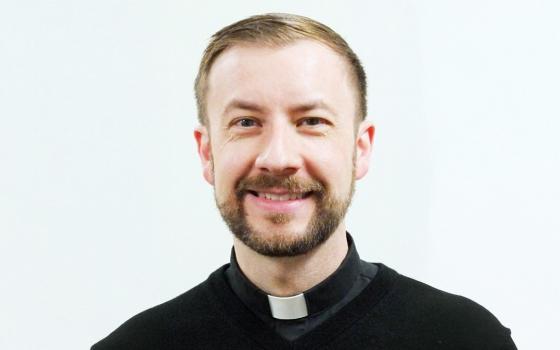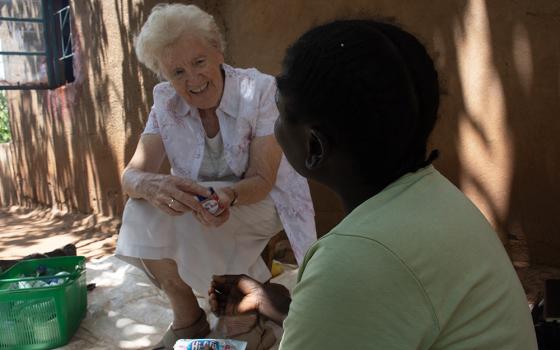
Throughout Holy Week, members and friends of the Atlantic Life Community answered the synod's call to be "a pilgrim of hope" by walking from New Haven to Groton, Connecticut, to draw attention to the urgent threat of nuclear weapons. (NCR/Michael Centore)
Throughout Holy Week, members and friends of the Atlantic Life Community answered the synod's call to be "a pilgrim of hope" by walking from New Haven to Groton, Connecticut, to draw attention to the urgent threat of nuclear weapons.
The Atlantic Life Community, which is celebrating its 50th anniversary, grew out of the Catholic antiwar movement of the 1960s. The now interfaith group includes Catholics, Protestants, Buddhists, Quakers and other nonviolent activists who gather periodically for acts of resistance and reconnection.
The pilgrimage along the Connecticut shoreline began on Palm Sunday (April 13) as participants set out from First & Summerfield Methodist Church in New Haven to Trinity Episcopal Church in Branford, where they were welcomed with an evening meal.
Patrick Carolan, a Connecticut resident who participated in the April 13 walk, reflected on the difference between a march and a pilgrimage: "A march tends to be more political. There is a spiritual component, but it's not always centered around spirituality. The pilgrimage is all about the spirituality. It gets to the whole concept of the oneness of all of us."
The April 14 portion of the pilgrimage picked up in Branford. Walkers from California, Massachusetts, Virginia and New York joined local residents to proceed east along Connecticut's Route 1.
Carrying signs and banners under a blue spring sky, the pilgrims were able to connect as they acknowledged support from passing traffic.
For Steve Baggarly of the Norfolk Catholic Worker, the act of pilgrimage was a "daylong meditation" and a way of "taking the message on the road."
Baggarly carried a sign in support of the United Nations Treaty on the Prohibition of Nuclear Weapons, which has been ratified by over 70 countries and effectively outlaws nuclear weapons internationally. The Vatican was the first state party to sign and ratify the treaty, though the U.S. and the other nuclear powers have yet to accept it.
"We've been working against nuclear weapons since 1987," said Baggarly, who has participated in Plowshares actions for nuclear disarmament. With the treaty, "it's nice to have something to work for."
Just one of the Columbia class submarines currently under construction as part of a 30-year, nearly $2 trillion upgrade of the U.S. nuclear arsenal has the power of 1,500 Hiroshimas, a sobering statistic in light of the 80th anniversary of the atomic bombings this year.
Given the gravity of the situation, "it's on [the U.S.] to take that first step" and ratify the Treaty on the Prohibition of Nuclear Weapons, Baggarly said. "That would show our political will to disarm. We have plans for nuclear war but no plans for disarmament."
The pilgrims were greeted for lunch on April 14 at St. George's Catholic Church in Guilford, a little over eight miles from their starting point that morning.
Mercy Sr. Eileen Hogan, of East Haven, Connecticut, helped coordinate hospitality at St. George's. She said that "the folks in the parish were really welcoming" to hosting the group.
Hogan also recalled her participation in pilgrimages, saying that they are a good tactic for activists "because you're together, and you'll always be together."
After lunch, pilgrims met up with members of the Guilford Peace Alliance to hold a vigil on the Guilford Town Green.
Frida Berrigan, a member of the Atlantic Life Community and organizer of the pilgrimage, said that vigils are a key part of "walking with a real spirit of invitation" as they allow for engagement with the public. That spirit was evident as passersby stopped to dialogue and ask questions.

Throughout Holy Week, members and friends of the Atlantic Life Community answered the synod's call to be "a pilgrim of hope" by walking from New Haven to Groton, Connecticut, to draw attention to the urgent threat of nuclear weapons. In this photo, pilgrims were received at the Shoreline Unitarian Universalist Society in Madison, Conn. (NCR/Michael Centore)
After a couple of hours on the green, participants readied themselves for the afternoon portion of the walk, a 3.5-mile route to the neighboring town of Madison. They were joined by members of the Nipponzan Myohoji Buddhist community, whose use of hand drums added a rhythmic cadence to the journey.
Berrigan said that while nuclear abolition was the main focus of the pilgrimage, organizers intended to present it as an intersectional issue.
"We wanted to 'both/and' it, for it to be about nuclear weapons and about Holy Week, and then to broaden out to embrace these other issues, like the love of humanity that is imperiled by nuclear weapons, and the love for and protection of the environment, which is under assault by nuclear weapons," she said.
Pilgrimage participant Jackie Allen-Douçot of the Hartford Catholic Worker highlighted the "connection between militarism and climate change." She described the walk as "a way to recommit myself to being a caretaker for creation."
It was a sentiment echoed by Linden Jenkins of Cambridge, Massachusetts. "It's about relationship, not resources," she said. "For substantive change to happen on one issue, it needs to happen on all issues."
The group arrived at the Shoreline Unitarian Universalist Society by late afternoon.
The walk continued along its coastal route on April 15, with a lunchtime vigil in the town of Clinton and an evening welcome at Westbrook Congregational Church. On April 16, pilgrims walked from Westbrook to Old Lyme.
Direct liturgical actions planned for the end of the week included a foot-washing ceremony at General Dynamics Electric Boat in Groton on Holy Thursday and a Stations of the Cross procession at the nearby U.S. Naval Base on Good Friday.
Also scheduled for Thursday was a panel hosted by the All Souls Unitarian Universalist Congregation in New London on the effects of General Dynamic Electric Boat on the local economy.
Electric Boat is one of two main submarine-production facilities in the U.S. It is currently under contract to build the first two of a planned fleet of 12 Columbia class submarines, in addition to other projects totaling nearly $2 billion. In 2024, it earned $3.8 billion in profit.
Among the featured panelists was author and activist Colleen Shaddox of East Haddam, Connecticut, presenting her report, "Electric Boat and the Connecticut Economy."
In 2018, the state gave Electric Boat a grant of $83 million. Shaddox set out to investigate how this money was spent through the Freedom of Information Act and was given highly redacted documents.
Her research shows the extent to which state taxpayers subsidize Electric Boat in the form of SNAP and Medicaid benefits for employees who are not paid a family-supporting wage. Taxpayers also subsidize workforce training and development, and the company receives sizeable tax abatements on its properties even as area residents' property taxes are increasing.
This public funding comes in addition to "cost-plus" contracts with the U.S. Navy allowing for wide margins of error.
"If the cost of the submarine goes up, the Navy just pays them more," Shaddox said. "It's an extraordinary arrangement. They literally cannot lose."
Berrigan said that Shaddox's report "complicates the narrative" that the military economy always benefits the local community.
"You can argue with the morality of it, but you're not supposed to be able to argue with the economy of it," she said.
Shaddox said she hopes the report will "get people's attention and get them asking questions."
"What other things could the state have done with that 83 million dollars? Things that are actually good for us and could give people good jobs," she said.
Advertisement





